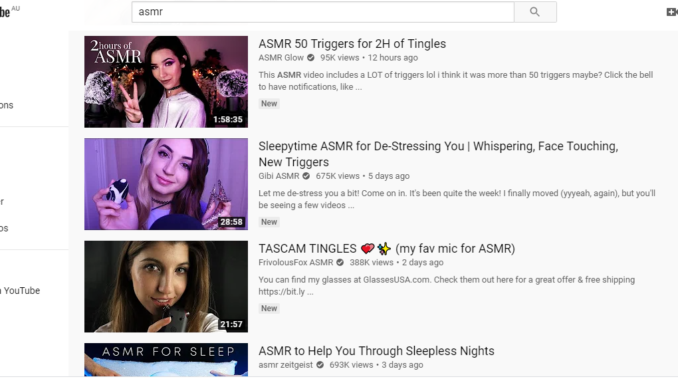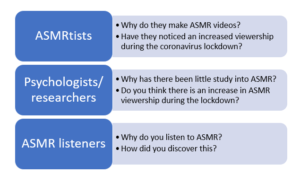
For my news feature, I’d like to explore the world of ASMR (autonomous sensory meridian response) and its (supposed) stress-relieving benefits in the uncertain period of the coronavirus pandemic.
According to Professor Craig Richard at Shenandoah University who runs an online archive called ASMR University, ASMR is a feeling of comfort. These sensations can be physical (such as pleasurable tingling or fuzziness in the head, neck, and/or arms) and psychological (such as feelings of calmness, sleepiness, or relaxation). They can be stimulated by different triggers like whispering, water sounds, tapping, or facial expressions.
YouTube has become a huge platform for ASMR videos. According to a feature by The New York Times, there are approximately 500 new ASMR videos uploaded per day. Some of the most popular videos are ‘roleplays’ that include spa treatments and doctors appointments. The key to these videos is the aspect of personal attention to you, the listener/ viewer.
Here’s a video of Ally, also known as ASMRrequests, in a 39-minute spa appointment video:
At this stage, you might be wondering-
Why is this timely or relevant?
A 2018 mental health report by Black Dog Institute revealed that close to one in four Australians experience some kind of mental health concerns. In the last month of social distancing and self-isolation due to the coronavirus, there have been worries that this may have been exacerbated.
Even the Australian government has recognised these concerns, having proposed a National Health Plan “to support the mental health and well-being of Australians” in these unprecedented times.
While there has been some academic research into the benefits of ASMR, health benefits that have identified include stress relief, inducing sleep for insomniacs, and helping those with depression.
In the stressful times of COVID-19, I’d like to explore – are people turning to ASMR for comfort?
Where could it be published?
My chosen publication is Vice, a youth-focused digital platform. Because of its target millennial audience, they are known to publish articles on topics that would typically be called quirky or unusual. I think a news feature on ASMR videos would fit nicely into this metric.

Moreover, they have an affinity to multimedia pieces, for which videos of ASMR would work wonderfully.
So how is it going to read?
In terms of structure, I’d like to begin with an introduction of ASMR. Then I’d like to answer my question by talking to three groups: ASMRtists (as these performers are known), listeners, and researchers/ psychologists who can provide some insight into the popularity of this fad.

I would also like to address a common belief that ASMR intended to be titillating. Prof. Richard of ASMR University has compared ASMR to oil, saying that it can heighten sexual moments but that it isn’t sexual in itself. Do ASMRtists, psychologists/ researchers, and listeners agree?
And how would it look?
Apart from including interviews and research, I would like to include multimedia like YouTube videos of different kinds of triggers and audio clips.





Hey Rhea, I would say that the topic is definitely interesting to explore. You’ve covered why the topic could be newsworthy and the approach that you would take towards forming your journalism piece.
Though I think it would be to nice to note in the proposal who or what channels can be contacted or interviewed for your article. Do you intend to ask the YouTubers who you have linked to in your proposal?
Also, what elements of multimedia, hypertext and interactivity do you intend to feature in your piece? Would you embed or hyperlink the interview materials or research that you have found during the course of writing this article?
Hi Rhea! This is a very interesting topic. Mental health issues during COVID-19 pandemic are vital, especially with the background that Australian government are implementing social distancing.
This topic definitely has timeliness as you introduced in your post. Considering many institutions are providing online counselling serivices during lockdown, do you think you can also put human interests in this story? As ASMR could really be a way treatment for people suffering from depression or anxiety and so on, you may also find a “human face” for your story, a person who is currently experiencing mental health issues and using ASMR as treatment. I suggest it can help build up a even better news story.
Hi Rhea, ASMR is a really interesting, relevant and current topic during the pandemic regarding mental health. Your research into the benefits of ASMR and the production of ASMR videos for consumers is very sound and well linked to sources throughout your post. Vice seems to be a good publication regarding their readership and your target audience, although, I think that the topic might be interesting to a wider audience depending on the angle and structure if it addresses benefits for mental health during COVID-19.
Looking at your argument and angle of your feature, I was a little unsure as I first thought you will be looking at the mental health benefits for consumers regarding your research but later wanted to explore if people are turning to ASMR during self-isolation. Therefore, I wondered if you might want to focus your article on one angle to keep the feature concise and the interviews manageable as it seems that each section of your article would require several interviews.
Considering your layout and structure, I really appreciated that you used subheadings, and multimedia content to break up the reading as well as attributing and linking to all your sources throughout, however, it could have been a little more concise by reducing the white space. Overall, a sum up of sources such as interviewees you are considering or have contacted as well as examples of multimedia that can be included would have given me a clearer idea of the final feature, but I am really looking forward to reading your final version.